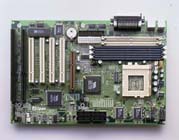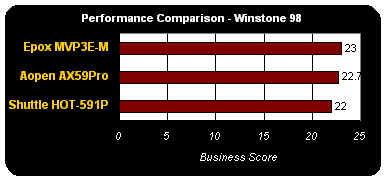
Original Link: https://www.anandtech.com/show/109
AOpen has consistently blessed their users with outstanding performance added to, not detracted by, rock solid stability and almost artistic engineering quality with their motherboards. For the most part their motherboards featured only Intel chipsets, perhaps AOpen never felt that any of the competing chipsets were up to their tough standards. Regardless of why, AOpen finally managed to release a successful non-Intel chipset based motherboard a few months back with their SiS 5582 contribution, the AP58. The AP58 turned out to be more of a low end solution with a fiery attitude, limited by the chipset AOpen went back to the drawing board this timed armed with a new tool no manufacturer so far seems to have mastered, the VIA MVP3 chipset. Adding a more high-end/professional touch to their non-Intel line, their MVP3 based AX59 receives the appended '-Pro' suffix to dignify this. Does the AOpen AX59 Pro have what it takes to be your new Super7 motherboard? Does it do the K6-2 justice? Starting with the specs, lets find out...
Anand Tech Report Card Rating
94/A
-- |
|
| CPU Interface | Socket-7 |
| Chipset | VIA MVP3 |
| L2 Cache | 512/1024KB |
| Form Factor | ATX |
| Bus Speeds | 60 / 66 / 75 / 83 / 90 / 100 / 112 MHz |
| Clock Multipliers | 2.0x - 5.5x |
| Voltages Supported | 1.30v - 3.5v (0.05/0.1v steppings) |
| Memory Slots | 3 168pin DIMM Slots
(EDO/SDRAM) 2 72pin SIMM Slots (EDO/FPM) |
| Expansion Slots | 1 AGP Slot 4 PCI Slots (4 Full Length) 2 ISA Slots (1 Shared / 2 Full Length) |
| BIOS | Award BIOS |
| Judging by the Motherboard Specifications alone, one would expect the AX59Pro to be a low-end BX motherboard, the only part preventing that from becoming reality is the strong presence of the VIA MVP3 chipset. Bordered on the South by an standard 512KB of Level 2 cache (1024KB optional, AnandTech tested a board equipped with 512KB) and closed off to the North by 3 DIMM and 2 SIMM slots, the MVP3 chipset is completely surrounded by the key components it provides power to. To the left of the VT82C598AT chip (Northbridge - the larger of two chips making up the MVP3 chipset) lies the AGP slot followed by 4 PCI slots and 2 ISA slots, all of which accept full length cards. While this may not seem like an important feature to look for, with quite a few Super7 (Socket-7 + AGP + 100MHz Front Side Bus support) motherboards designed in such a manner that one cannot even use a single Voodoo2 board due to the length of the card it is important that you look for a board that will allow you to use full length PCI cards if you plan on installing any. |  |
Courtesy of the MVP3 chipset, users have the option of taking advantage of the 2 SIMM slots on the AX59Pro by enabling a pseudo-synchronous memory bus operation mode which clocks the memory bus at the AGP clock (usually around 66MHz) with the CPU and L2 cache deriving their speed directly from the Front Side Bus (FSB). Of course, meeting the requirements for a true Super7 motherboard, the AX59Pro features both a 1/2 and 1/3 PCI clock divider to keep the PCI bus running as close to 33MHz as possible.
The layout of the AX59Pro is fairly spacious, while not as large as the Epox MVP3E-M it does pack a considerable punch. AOpen managed to outfit the AX59Pro with a highly configurable voltage list, ranging from core voltages of 1.30v to 3.5v with the steps between 1.30v and 2.05v made in 0.05v jumps and those made between 2.0v and 3.5v in 0.1v leaps. It is doubtful that you'll ever need to use the 1.30v setting, but it is nice to know that the AX59Pro offers you more than just the standard options when it comes to voltages, and in this case, also when it comes to Bus Frequencies. The AX59Pro goes above and beyond the 100MHz FSB setting by offering an overclocked 112MHz FSB speed for those daring enough to give it a try. In addition to 100/112MHz FSB frequencies, AOpen's MVP3 beauty features the usual set of 60/66/75/83MHz settings as well as the unique 90MHz setting. The clock multiplier and core voltage settings are controlled via a corner located Dip Switch on the board, with the FSB settings controlled by a jumper block beneath the first DIMM slot.
Standard with the AX59Pro is AOpen's first class User's Guide made entirely out of recycled paper. The information contained within the documentation thankfully doesn't reflect the recycled nature of the paper it was printed on as it isn't simply a "cut-and-paste" of generic manuals, rather an original collection of data/useful information that closely pertains to this specific product alone, a concept a surprising number of manufacturers have failed to grasp. As with most newer AOpen motherboards, the AX59Pro's attractive box also is home to the AOpen Bonus Pack CD-ROM which contains a current version of Symantec's Norton AntiVirusTM software. The CD also contains the standard set of drivers, Flash BIOS Utilities, Desktop Managers, and on-line documentation.
In the tests AnandTech conducted, the AP59Pro made it as high as 315MHz (90 x 3.5) reliably, with 100 x 3.0 being the fastest overall setting due to the performance boost courtesy of the 100MHz FSB speed. Stability at all overclocked speeds achieved reliably was not a factor at all, not to mention the board's rock solid performance at all standard speeds. The performance of the AX59Pro is currently closest to that of the Epox MVP3E-M which is available with a full megabyte of cache, a feature that not only increases in the cacheable memory limit of the motherboard to 256MB but offers a slight performance boost in some situations over boards equipped with only 512KB of cache. Even in spite of this, the 512KB AX59Pro (128MB Cacheable Memory Area) came quite close to the performance of the MVP3E-M, close enough to be considered virtually identical.
Where is the one PCI slot that we sacrificed a third ISA slot for? The AX59Pro would have probably taken the lead among its competitors had it featured a full 5/2/1 (PCI/ISA/AGP) expansion slot configuration instead of the incomplete 4/2/1 setup it boasts.
In spite of the excellent layout of the motherboard, the jumpers can still be a pain to configure, and the CPU Socket does not fall in the path of the ATX Power Supply, therefore posing some possible cooling issues when overclocking you system.
Another disappointment was the 112MHz FSB setting which wasn't stable enough to completely boot into Windows 95, a shame since running a K6-2 at 336MHz (112 x 3.0) would be a dream come true for quite a few soon-to-be K6-2 owners.
AOpen has the best ATX MVP3 motherboard AnandTech has looked at so far, although that may seem like much the only board it has to compete with is the Epox MVP3E-M which doesn't fall that far behind it in terms of overall value.
Allows user to individually set IRQs for each Legacy ISA card
Allows users to manually assign IRQs based on PCI slot location
Recommended SDRAM: AMM PC100 SDRAM, Azzo PC100
SDRAM, Corsair PC100 SDRAM; Memory Man PC100 SDRAM
SDRAM Tested: 1 x 64 AMM PC100 SDRAM, 1 x 64 Azzo PC100 SDRAM, 1 x 64MB Corsair PC100
SDRAM; 1 x 64MB Memory-Man PC100 SDRAM
Manufacturer: Advanced American Megatrends
Technologies
Purchase Web-Site: http://www.megacom.com
Manufacturer: Azzo Computers
Purchase Web-Site: http://www.azzo.com
Manufacturer: Corsair Microsystems
Purchase Web-Site: http://www.tccomputers.com/
Manufacturer: The Memory Man
Purchase Web-Site: http://www.memory-man.com
Click here to find lowest prices on this product.
The Test
In recent times, choosing a motherboard cannot be completely determined by a Winstone score. Now, many boards come within one Winstone point of each other and therefore the need to benchmark boards against each other falls. Therefore you shouldn't base your decision entirely on the benchmarks you see here, but also on the technical features and advantages of this particular board, seeing as that will probably make the greatest difference in your overall experience.
How I Tested
Each benchmark was run a minimum of 2 times and a maximum of 5 times, if the motherboard failed to complete a single test within the 5 allocated test runs the OS/Software was re-installed on a freshly formatted Hard Drive and the BIOS settings were adjusted to prevent the test from failing again. All such encounters were noted at the exact time of their occurrence.
Business Winstone 98 was run at each individually tested clock speed, if reliable scores were achieved with the first two test runs of the suite an average of the two was taken and recorded as the final score at that clock speed. If the test system displayed erratic behavior while the tests were running or the results were incredibly low/high the tests were re-run up to 5 times and an average of all the test runs was taken and recorded at the final score at that clock speed
After each motherboard was tested a complete format of the test hard drive was initiated and the OS/benchmarking software was re-installed afterwards a defragment was initiated using Windows 95's Disk Defragmentation Utility
Tests using AGP Video cards were only run under Winstone 97, as the AGP Millennium II does not affect the Business Winstone 98 score when compared to the PCI Millennium II used in the tests.
No foreign drivers were present in the test system other than those required for the system to function to the best of its ability
All foreign installation files were moved to a separate partition during the test as to prevent them from effecting the test results
All tests were conducted at 800 x 600 x 16-bit color depth
Test Configuration |
|
| Processor(s): | AMD K6/300 AFR AMD K6-3D 300 AFR Intel Pentium MMX 233 Cyrix 6x86MX-PR2/200 |
| RAM: | 1 - 64MB AMM DIMM 1 - 64MB Azzo DIMM 1 - 64MB Corsair DIMM 1 - 64MB Memory Man DIMM |
| Hard Drive(s): | Western Digital Caviar AC35100 - UltraATA |
| Video Card(s): | Matrox Millennium II (4MB WRAM - AGP) |
| Bus Master Drivers: | VIA 2.14 |
| Video Drivers: | MGA Millennium 4.07.00.700 VIA GART VxD v1.7 |
| Operation System(s): | Windows 95 Service Release 2.1 |
| Motherboard Revision: | AOpen AX59PRO v1.1 |
Ziff Davis Winstone - Windows 95 Performance |
||
| Winstone 98 | Winstone 97 | |
| Business | Business | |
| AMD K6/300 - 66MHz x 4.5 | 20.7 | 60.4 |
| AMD K6/300 - 100MHz x 3.0 | 22.7 | 65.3 |
| AMD K6/315 - 90MHz x 3.5 | --- | 64.7 |
| AMD K6/336 - 112MHz x 3.0 | Failed | Failed |
| Intel Pentium MMX 233 - 66MHz x 3.5 | --- | 52.8 |
| Cyrix 6x86MX PR2/200+ - 66MHz x 2.5 | --- | 54.9 |

If you must have an ATX Super7 motherboard now, the AOpen AX59Pro will probably be your best choice, however if you can wait then it is best that you do as there is still much to be desired from the Super7 motherboards on the market today.







